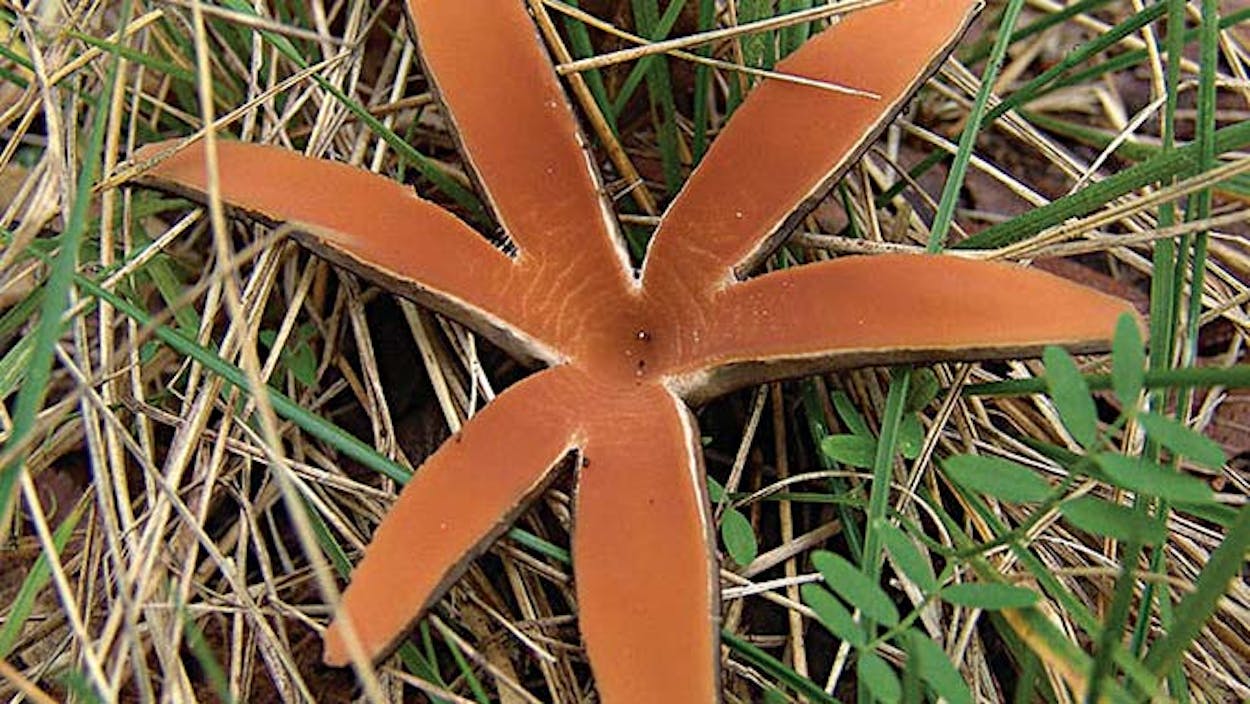It all started with a dog. My friend’s bulging-eyed, pointy-eared terrier that I said looked like a gremlin. Or was it a mogwai? As the hour and the wine waned, she explained the difference between the two, a conversation that put me in mind of gnarly creatures that emerge when conditions are just right. And that’s how we ended up in my backyard, shining a flashlight on two dark-brown, stubby protuberances, one menacingly closed up tight and the other an otherworldly “blossom” of fleshy, orange-hued petals.
They looked—if you’ll indulge me another cinematic reference—a lot like miniature versions of the eggs Ripley and Newt confront in Aliens, except less attractive. A Google image search using some variation of the words “brown pointy mushroom thingie backyard” revealed that we were in the presence of the devil’s cigar, a “very rare fungus” that has been found in only two places, Texas and Japan. As if that weren’t intriguing enough, we learned that it also makes a hissing sound that can be heard from several feet away as it opens up and spews its spores. Holy shiitake.
Enter an expert to allay all this talk of pods and monsters. “It’s probably not as rare as we think,” says David Lewis, the president of the Gulf States Mycological Society, “because I keep getting reports of them.” From his sixty acres in Newton County—“my own private mushroom preserve”—the former chemist with four species named after him also receives mailed-in specimens of the fungus from amateur mycologists and fields lots of phone calls regarding edibility (“Too tough to eat, I suspect”) and toxicity (“We don’t have enough data to say”). As for its appearance in only a handful of Central and North Texas counties and the Nara, Miyazaki, and Kochi prefectures of Japan, he says that it’s not at all uncommon for related species to pop up thousands of miles away from each other; it’s called disjunct distribution, in which organisms can be dispersed in a number of ways, like going with the flow of continental drift or hitching a ride on oceangoing vegetation. Some theorize that this particular fungus was transported by spore-carrying dust storms at least 19 million years ago. “But it is unique to Texas, as far as North America is concerned,” Lewis says. “That it grows in a narrow band from Austin up to Dallas probably means it likes the limestone soils.”
Chorioactis geaster was first collected in Austin in 1893 by Lucien Marcus Underwood, a noted botany professor, who would later come undone by financial woes and insomnia and try to kill his wife and daughter before committing suicide (“As jolly a fellow as you would care to meet,” a colleague told the New York Times’s obituary writer). Also called Texas stars, the mushrooms are often found clustered around the roots of the cedar elm tree (which I happen to have in my yard) and reportedly feel most at home in areas smothered in decomposing organic matter (my grassless yard is blanketed with leaves and beer cans from the unofficial frat house next door). They mostly come out in the winter—mostly—and they have many enthusiastic fans, including, apparently, former state senator Chris Harris, of Arlington, who in 1997 decided that this funky fungus should take its place alongside the bluebonnet, side-oats grama, and ever-peculiar armadillo as a symbol of our state’s “great diversity.”
Alas, Harris’s resolution to make the “rare mycological inhabitant” the official fungus of Texas passed the Senate but not the House. “That was a neat idea,” Lewis says, laughing, “but I guess it didn’t fly with the Legislature, did it? Stick-in-the-muds.”









